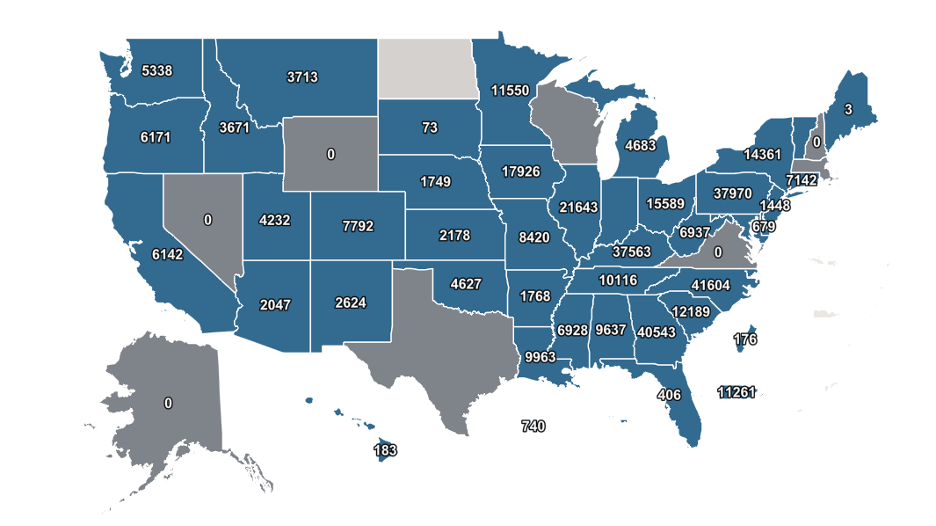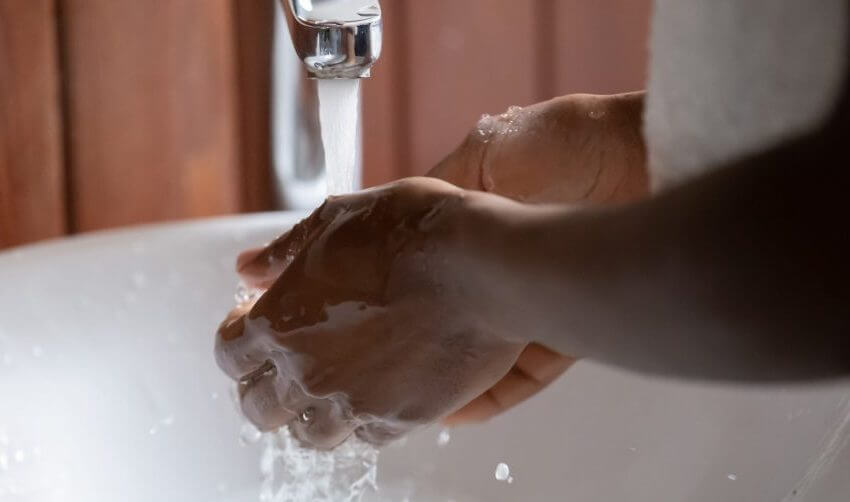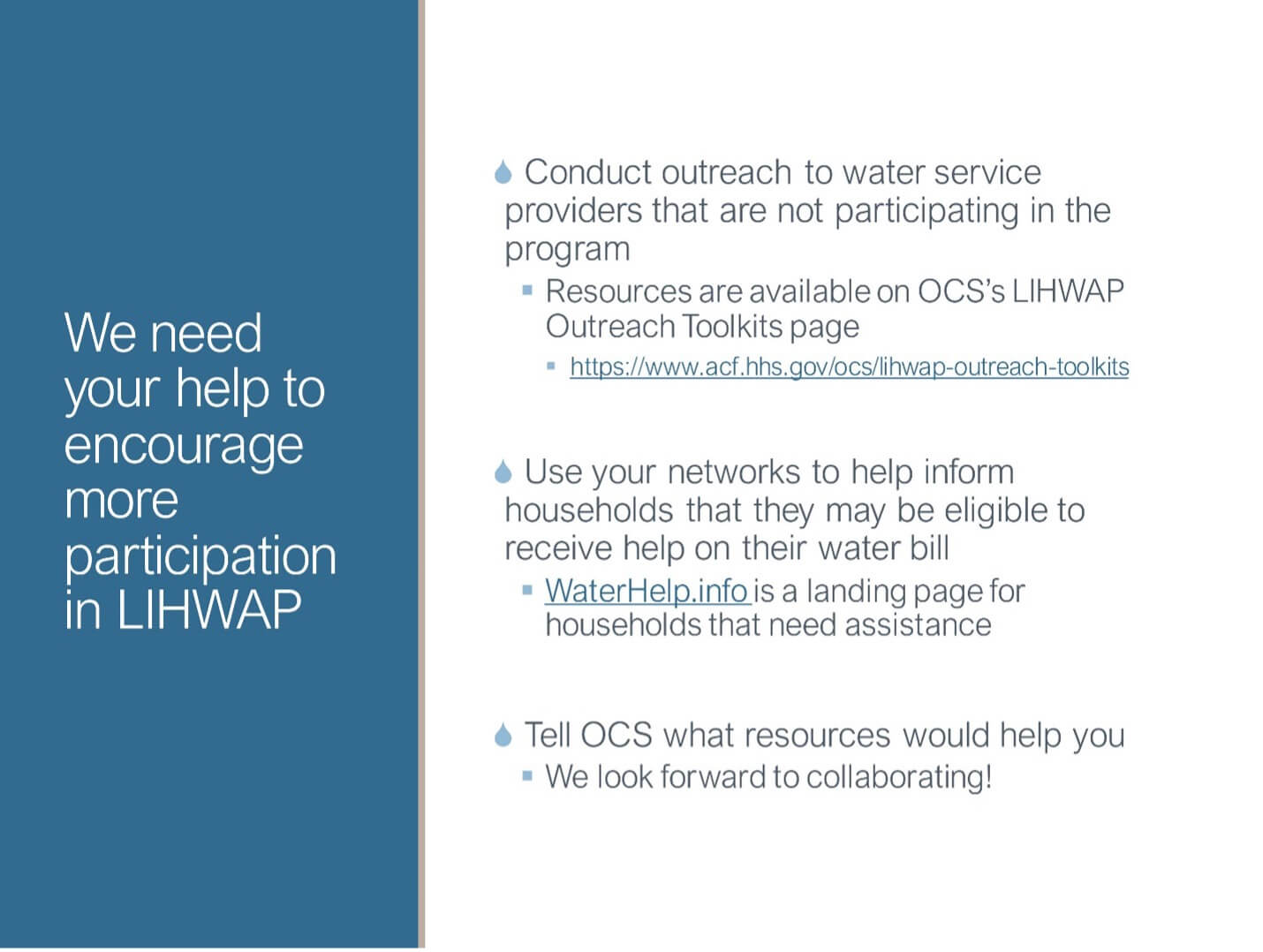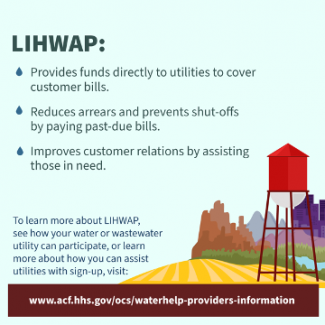Low-Income Household Water Assistance Program: Annual Report Look Back
This is the fourth blog post we’ve written about the Low-Income Household Water Assistance Program (LIHWAP) since it was first funded through COVID-19 legislation in 2020 and 2021. For background on the establishment of the program and what it’s achieved so far, take a look at the previous blogs:
- Low-Income Household Water Assistance Program Check-In, Oct 2022
- Low-Income Household Water Assistance Program Updates, May 2022
- Moving Toward Water Equity & Affordability: Low Income Household Water Assistance, April 2021
The Low-Income Household Water Assistance Program (LIHWAP) is currently set to expire on September 30, 2023, unless additional funds are secured to continue the program. Administered by the Department of Health and Human Services’ (HHS) Administration for Children and Families’ Office of Community Services (OCS), LIHWAP supports low-income households facing difficulties paying for their drinking water and wastewater services. The program has assisted over 433,000 households since its initiation with participation from at least 52 states/territories and 70 Tribes to date. Because of both the great need and impact of the program, many advocates are working with members of Congress to advocate for a continuation of LIHWAP by securing additional funding in the current fiscal year (FY) 2024 appropriations process.
Key Points of the Annual Report
The most recent LIHWAP report includes data through September 30, 2022. This annual reporting requirement helps HHS track program implementation throughout the year. Quarterly data is also reported for additional tracking and analysis. These reports provide insights into the accomplishments and challenges of the program. States serving the most households so far include North Carolina (41,604), Georgia (40,534), and Pennsylvania (37,970). While some communities have expended most of their awarded funds, including Washington, DC, American Samoa, and Kentucky, others, like Alaska and Virginia, have not spent any of the allotted amounts. Several states are set to receive additional monies in May through the voluntary return of some ARPA funds.
| States/Territories Returning Unspent ARPA $ | States/Territories Receiving Additional ARPA $ |
|---|---|
| Missouri, Maine, Idaho, South Dakota, Vermont, and New Hampshire | Georgia, Pennsylvania, Iowa, Kentucky, Virginia, Washington DC, American Samoa, and Puerto Rico |
Of the $1.1 billion in total funding, $221.3 million has been spent. A larger amount of $796.7 million funds has been obligated to be spent, meaning that states, territories, and Tribes have selected vendors to send their funds to before the program’s end date. As states move to spend their funding prior to their expiration, they have faced difficulties identifying willing water service providers to participate. Only 13,340 water and wastewater vendors have agreed to participate, a much smaller percentage (~26%) of the total 50,000+ services in the U.S.

Among the households assisted by LIHWAP, there is an average weighted benefit of $344. Those benefits include restoration of services (i.e., turning the water or wastewater back on in a household where it had been shut off), prevention of disconnections, and reduction of rates charged. For financially struggling households, these benefits have been invaluable.
Vulnerable, or “target,” populations are a particular focus of LIHWAP support: 24% of households served had people with disabilities living there; 22% included homes with older adults; and 16.8% had children under the age of 5. One example of LIHWAP supporting a large vulnerable population is the San Carlos Apache Reservation, where 42% of its tribal members are under 18 years of age. (You can watch a video about the Tribe’s implementation of LIHWAP here.) LIHWAP is covered by the Justice40 Initiative, which aims to direct 40% of Federal investments and benefits to disadvantaged, overburdened communities.
States Ramp-Up Implementation of LIHWAP
Recently, in March of this year, three states expanded the scope and eligibility of their programs to aid in the distribution of funds. California’s Department of Services and Development (CSD) announced they would expand LIHWAP “to include all eligible low-income households.” This changes the earlier requirement of households needing to have a past-due balance and be at risk of disconnection or already disconnected from their water/wastewater services. Oregon’s Housing and Community Services Department issued a temporary administrative order to update their program’s manual to “increase spending statewide, allow for households in greater need to receive equitable assistance, and ensure the federal funding is exhausted by the program end date.” Similarly, Arkansas’ Energy Office is now offering up to $2,000 “to help qualified, low‐income households pay their residential water or wastewater past‐due balances,” essentially providing a free year of service if eligible. These changes illustrate a push to assist more households after initial requirements from the first year of operating the program. They come as the programs’ expiration date approaches at the end of this year, marking an urgent need to obligate and spend the funds awarded by HHS.
 Other states are also utilizing LIHWAP as an opportunity for increasing equitable outcomes in other ways, such as preventing debt-related water shutoffs. New Jersey is a recent example, as the governor signed a bill in April prohibiting non-participating water and wastewater providers from taking specific actions against customers with arrearages, including water shutoffs. This creates pressure on those vendors to participate in the state’s LIHWAP program, hopefully increasing the number of households receiving benefits. Using a different tactic to increase beneficiaries, Ohio’s Department of Development teamed up with The Breathing Association, an Ohio-based nonprofit organization, to assist eligible households. In one local news article, a participant of Ohio’s LIHWAP program expressed her gratitude for the aid she received from the nonprofit for getting her water turned back on quickly.
Other states are also utilizing LIHWAP as an opportunity for increasing equitable outcomes in other ways, such as preventing debt-related water shutoffs. New Jersey is a recent example, as the governor signed a bill in April prohibiting non-participating water and wastewater providers from taking specific actions against customers with arrearages, including water shutoffs. This creates pressure on those vendors to participate in the state’s LIHWAP program, hopefully increasing the number of households receiving benefits. Using a different tactic to increase beneficiaries, Ohio’s Department of Development teamed up with The Breathing Association, an Ohio-based nonprofit organization, to assist eligible households. In one local news article, a participant of Ohio’s LIHWAP program expressed her gratitude for the aid she received from the nonprofit for getting her water turned back on quickly.
Opportunities for Advocacy
As the year progresses and states continue disbursing their funds before they expire, we may see a trend in program eligibility expansions and increased pressure on utilities to participate. The liquidation deadline for programs is presently December 31, 2023.
During the current FY24 appropriations process, several sign-on letters from water affordability advocates have recommended investing between $500 million and $1 billion, over the course of 1-2 years, to continue running LIHWAP until the establishment of a permanent federal low-income water assistance program. The Bipartisan Infrastructure Law (BIL) included authorizing language for a needs assessment and pilot Rural and Low-Income Water Assistance program to be housed at EPA, but has yet to receive funding.
President Biden’s proposed budget suggests that funding for LIHWAP be included in the long-running Low-Income Home Energy Assistance Program(LIHEAP) budget, ultimately letting states choose to use a portion of their LIHEAP funds for water bill assistance.
Many water and affordable energy advocates oppose the combination of LIHWAP and LIHEAP as it raises concerns about potential competition for funding, especially with the need outweighing the funding available. Most believe funding for LIHEAP and LIHWAP should remain separate to avoid these concerns.
Longer-term, the various levels of federal, state, and local governments need to create true water affordability solutions, such as more affordable rate structures. In the short-term, the immediate need for water assistance for households struggling to pay their water bills remains. Advocates can take this opportunity to continue raising the importance of water assistance with their elected officials and urge them to support LIHWAP funding and maintaining drinking water and wastewater services for all households, regardless of income.
Freshwater Future, a nonprofit based in the Great Lakes region, spoke on the changes needed to address the current barriers and pitfalls of the program: “Because LIHWAP was created to assist residents in crisis, it is imperative that state and federal governments treat it as such and reduce barriers to apply and access these funds. This includes making utility participation mandatory; enabling auto-enrollment for those already receiving government benefits; providing multiple ways to apply with options for those with limited English proficiency; and allowing self-attested income.”

What has the administration of LIHWAP funds in your state or community been like? Do you think the program should continue? If so, how? We want to hear your thoughts! Join our monthly Drinking Water Access Exchange meeting or leave a comment below.






[…] Low-Income Household Water Assistance Program: Annual Report Look Back, May 2023 […]